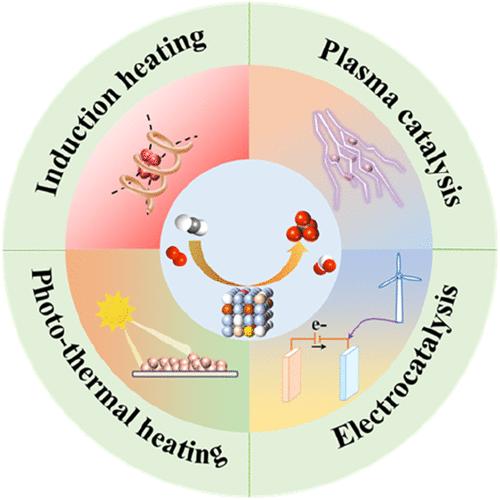二氧化碳甲烷化过程研究进展及展望
IF 13.1
1区 化学
Q1 CHEMISTRY, PHYSICAL
引用次数: 0
摘要
催化CO2转化不仅可以有效缓解CO2的排放,还可以将其转化为高附加值的产品,这对于实现世界上许多国家的中长期碳调峰和碳中和战略目标具有重要意义。二氧化碳甲烷化作为电制气(PtG)技术链中的关键步骤,被认为是最有前途的二氧化碳利用途径之一。由于CO2分子的化学惰性和热力学稳定性以及该反应的强放热性质,因此具有合适的活性和耐烧结性的催化剂以及具有良好热管理能力的催化体系是其工业应用的关键因素。近几十年来,感应加热(IH)、等离子体、光热催化以及电催化等方法被用于提高催化CO2甲烷化的整体性能。本文从催化剂和催化系统设计两方面对CO2甲烷化研究的最新进展进行了综述。并对这些技术的未来发展和面临的挑战进行了讨论。本文章由计算机程序翻译,如有差异,请以英文原文为准。

A Review of CO2 Methanation Process: Recent Advances and Future Prospects
Catalytic CO2 conversion can not only effectively alleviate CO2 emissions but also convert it into high-value-added products, which is of great significance for achieving the mid-to-long-term strategic goals of carbon peaking and carbon neutrality in many countries around the world. CO2 methanation, as a key step in the Power-to-Gas (PtG) technology chain, has been considered to be one of the most promising routes for CO2 utilization. Due to the chemical inertness and thermodynamic stability of the CO2 molecule and the strong exothermic nature of this reaction, catalysts with suitable activity and sintering resistance, as well as catalytic systems with desirable heat management capability, are the key factors regarding its industrial application. Induction heating (IH), plasma, photothermal catalysis, as well as electrocatalysis approaches have been employed to boost the overall performance of catalytic CO2 methanation in recent decades. Herein, the recent state-of-the-art advances in CO2 methanation in the above aspects have been fully summarized in terms of both catalyst and catalytic system design. Future development and challenges of these technologies for CO2 methanation have also been discussed.
求助全文
通过发布文献求助,成功后即可免费获取论文全文。
去求助
来源期刊

ACS Catalysis
CHEMISTRY, PHYSICAL-
CiteScore
20.80
自引率
6.20%
发文量
1253
审稿时长
1.5 months
期刊介绍:
ACS Catalysis is an esteemed journal that publishes original research in the fields of heterogeneous catalysis, molecular catalysis, and biocatalysis. It offers broad coverage across diverse areas such as life sciences, organometallics and synthesis, photochemistry and electrochemistry, drug discovery and synthesis, materials science, environmental protection, polymer discovery and synthesis, and energy and fuels.
The scope of the journal is to showcase innovative work in various aspects of catalysis. This includes new reactions and novel synthetic approaches utilizing known catalysts, the discovery or modification of new catalysts, elucidation of catalytic mechanisms through cutting-edge investigations, practical enhancements of existing processes, as well as conceptual advances in the field. Contributions to ACS Catalysis can encompass both experimental and theoretical research focused on catalytic molecules, macromolecules, and materials that exhibit catalytic turnover.
 求助内容:
求助内容: 应助结果提醒方式:
应助结果提醒方式:


